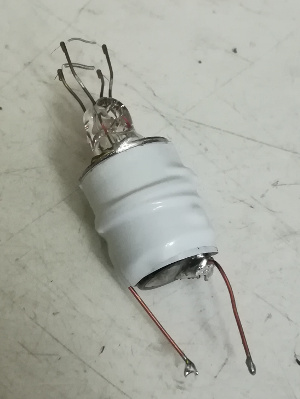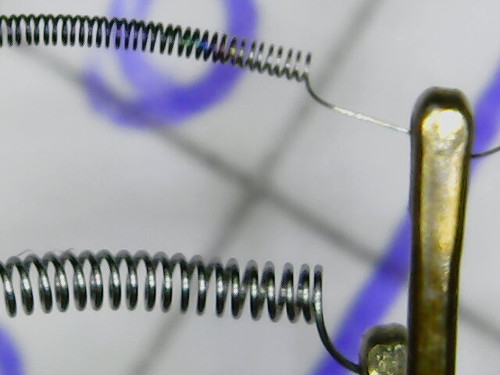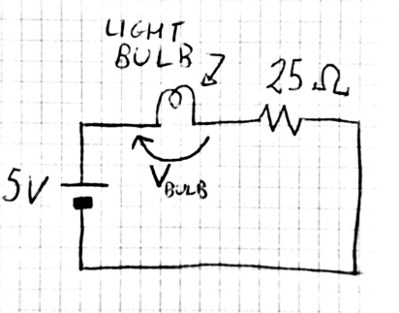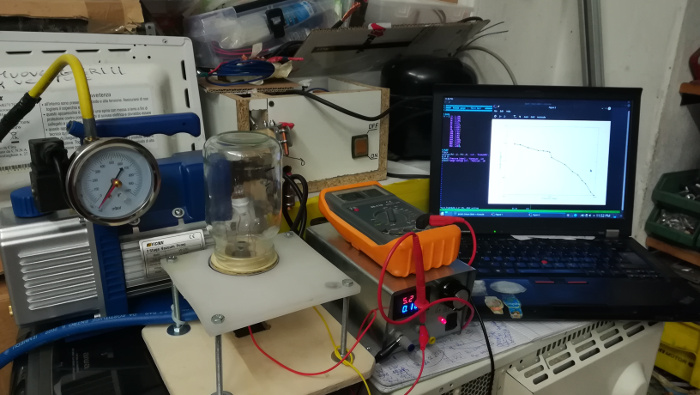Light bulb Pirani vacuum gauge - preliminary test
Cremona, Feb 2018.
These are a few notes and pictures about some testing of a light bulb filament used as a vacuum gauge.
This page is in the "junk" directory! Make sure you check some better material as well, on
the main page
:-)
Intro
The theory here is that if you heat up a tiny wire and put it into a gas environment, the wire will exchange heat
with the surrounding gas and it will settle at a certain equilibrium temperature.
Higher heat flux means higher "cooling power" of the gas and will thus result in a lower temperature of the filament.
Lower heat flux implies that the filament heats up more.
Now, since the temperature modifies the electrical resistance of the wire, we can connect a battery to it, and by
measuring the voltage drop we can understand what the heat flux is (joule heating).
Yeah, but.. What's special with the heat flux?
It is directly related to the gas pressure!
In particular, when the flow gets rarefied (at low pressure values), the heat flux gets proportional to the gas pressure
(and therefore density) and one can use such device as a vacuum-meter.
Such device is termed "Pirani gauge".
Simplest Pirani gauge
Take a lightbulb, remove its glass envelope and expose the filament to the
low pressure environment.
Here's your first low-quality (very low..) Pirani gauge.
Here it is, with a couple wires poorly soldered.

You need a low voltage light bulb, and you need one that does not drain too much current to
heat up, or you'll need a good power supply.
I used a 12V, 5W light bulb, that turns out to have a resistance (when cold)
of about 4.2 ohms.
In the image above, you can see the bulb I'm using
(25 cents bulb.. Not bad, right?)
It's a two-filament bulb (one is 5W and the other 21W or so):
just forget about the thick filament and use the 5W one.
Here's a closeup view of the filament after some testing.
I think I kind of heated it up a bit more than intended, because at a point it started
turning dark, as you can see.
The operating temperature shoud be not too high... something like 500 °C max let's say.
Ignore the biggest filament in the picture.

The filament diameter is approximately 0.02 mm, and the curly part is around 6 mm
in length.
The spiral diameter is something around 0.2 or 0.4 mm.
Simplest electric circuit
There are three operation modes for a Pirani gauge, the most accurate of which keeps
the wire temperature constant.
Also, almost all of them use a Wheatstone bridge.
To keep it simple - that's a preliminary test, right? - this is my utterly simple
schematic:

About the components:
I used two 47k, 5W resistors saved from the junk, plugged in parallel to give a
more or less 25 ohms resistor.
This value seemed reasonable to me (the cold resistance of the wire is around 4.2 ohms),
and these were the first resistors that came out of my electronics box.
A 5V VSS was chosen to keep the filament relatively cold and prevent it to burn in the
not-so-vacuum atmosphere.
The voltage is to be measured at the ends of the bulb filament, and what we expect is
to measure an increasing voltage as the flow gets rarefied, since the filament
will heat up due to fewer air molecules cooling it down.
Simplest vacuum chamber
So, let's put the filament in a "vacuum jam-jar chamber" and pump out the air.
Here's a pic of the whole system.

Forgive the background mess.
Data acquisition
Or... "simplest data acquisition" if you like.
The idea here is pumping some air out of the jar and write down the pressure (as
read from the pump manometer) and the voltage on the filament.
Hey, it's working! :-)
Data looks like this:

We can plot it.
Also, we can apply the voltage Kirchhoff law on the circuit and with a bit of algebra
find out the power dissipated by the filament (q = V*I = V*(Vs - V)/R), with Vs = 5V and R = 25 ohm), assuming that it is all
dissipated by conduction with air, no radiation and no prongs conduction.

Question: isn't the heat flux supposed to decrease at lower pressures?
Answer: well, yes, if you keep the same filament temperature throughout the
experiment!
This is not the case in that simple experiment, where the increasing temperature ends up increasing the heat flux.
Keep reading for more details.
More advanced version
A more serious version keeps the filament temperature constant.
To do that you need a circuit with some type of feedback.
The same problem appears in hot wire anemometry, so you may use this keyword to find
some schematics.
I suggest you to take a look here.
LINKS
Take a look at those good links:
Cheers!
Back to the main page





